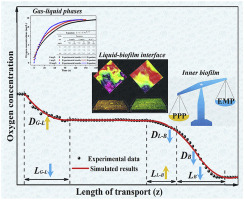当前位置:
X-MOL 学术
›
Water Res.
›
论文详情
Our official English website, www.x-mol.net, welcomes your
feedback! (Note: you will need to create a separate account there.)
Insights into spatial effects of ceria nanoparticles on oxygen mass transfer in wastewater biofilms: Interfacial microstructure, in-situ microbial activity and metabolism regulation mechanism.
Water Research ( IF 11.4 ) Pub Date : 2020-03-19 , DOI: 10.1016/j.watres.2020.115731 Guoxiang You 1 , Chao Wang 1 , Peifang Wang 1 , Jun Hou 1 , Yi Xu 1 , Lingzhan Miao 1 , Tao Feng 1
Water Research ( IF 11.4 ) Pub Date : 2020-03-19 , DOI: 10.1016/j.watres.2020.115731 Guoxiang You 1 , Chao Wang 1 , Peifang Wang 1 , Jun Hou 1 , Yi Xu 1 , Lingzhan Miao 1 , Tao Feng 1
Affiliation

|
Growing international exploitation of ceria nanoparticles (CeO2 NPs) for varied applications has increased their release into wastewater treatment plants. Mass transfer of oxygen (MTO) in wastewater biofilm is of considerable importance to influence the activity and purification ability of biofilm. Herein, we investigated the spatial distribution of oxygen in gas-liquid-biofilm phases, the microstructure of interfaces and the in-situ microbial activity to reveal the impacts of CeO2 NPs on MTO in wastewater biofilm and the related mechanisms. After exposure to 1 and 10 mg/L CeO2 NPs, the oxygen transfer coefficient (KLa) from gas to wastewater increased by 28.1% and 75.3% with a reduction of thickness in gas-liquid boundary layer, indicating the enhanced MTO in gas-liquid interface. In contrast, the MTO in liquid-biofilm interface was negatively affected and the thickness of liquid-biofilms boundary layer significantly increased, which was mainly attributed to the smoother surface and the decreased surface area difference of biofilm. Within biofilm, the microbial activity was inhibited by 10 mg/L CeO2 NPs, whereas the production of extracellular polymeric substance (EPS) was significantly improved, leading to a decline of 35.0% in the internal effective diffusivity (DB) and a 300-μm reduction of oxygen penetration depth. Moreover, the relative activities of key enzymes involved in glycometabolism indicated the transition of Embden-Meyerhof pathway to pentose phosphate pathway, which probably contributed to the enhanced EPS production and consequently increased mass transfer resistance in liquid-biofilm interface and inner biofilm. These results could potentially expand the knowledge on mass transfer of nutrients or pollutants in wastewater biofilm in response to NPs exposure.
中文翻译:

氧化铈纳米颗粒对废水生物膜中氧气质量转移的空间影响的见解:界面微结构,原位微生物活性和代谢调节机制。
二氧化铈纳米颗粒(CeO2 NPs)在国际上的日益广泛的利用已增加了其向废水处理厂的排放。废水生物膜中氧气的质量转移(MTO)对于影响生物膜的活性和净化能力具有相当重要的意义。在这里,我们调查了氧在气-液-生物膜相中的空间分布,界面的微观结构和原位微生物活性,以揭示CeO2 NPs对废水生物膜中MTO的影响及相关机理。暴露于1 mg / L和10 mg / L的CeO2 NPs后,从气体到废水的氧转移系数(KLa)分别增加了28.1%和75.3%,并且气液边界层厚度减小,表明气液中的MTO增强接口。相反,液-生物膜界面的MTO受到负面影响,液-生物膜边界层的厚度明显增加,这主要归因于生物膜表面较光滑,表面积差异减小。在生物膜内,微生物活性被10 mg / L CeO2 NPs抑制,而胞外聚合物(EPS)的产生得到显着改善,导致内部有效扩散率(DB)下降了35.0%,而300μm减少氧气渗透深度。此外,参与糖代谢的关键酶的相对活性表明Embden-Meyerhof途径向戊糖磷酸途径的转变,这可能有助于提高EPS的产生,从而增加液体-生物膜界面和内部生物膜的传质阻力。
更新日期:2020-03-20
中文翻译:

氧化铈纳米颗粒对废水生物膜中氧气质量转移的空间影响的见解:界面微结构,原位微生物活性和代谢调节机制。
二氧化铈纳米颗粒(CeO2 NPs)在国际上的日益广泛的利用已增加了其向废水处理厂的排放。废水生物膜中氧气的质量转移(MTO)对于影响生物膜的活性和净化能力具有相当重要的意义。在这里,我们调查了氧在气-液-生物膜相中的空间分布,界面的微观结构和原位微生物活性,以揭示CeO2 NPs对废水生物膜中MTO的影响及相关机理。暴露于1 mg / L和10 mg / L的CeO2 NPs后,从气体到废水的氧转移系数(KLa)分别增加了28.1%和75.3%,并且气液边界层厚度减小,表明气液中的MTO增强接口。相反,液-生物膜界面的MTO受到负面影响,液-生物膜边界层的厚度明显增加,这主要归因于生物膜表面较光滑,表面积差异减小。在生物膜内,微生物活性被10 mg / L CeO2 NPs抑制,而胞外聚合物(EPS)的产生得到显着改善,导致内部有效扩散率(DB)下降了35.0%,而300μm减少氧气渗透深度。此外,参与糖代谢的关键酶的相对活性表明Embden-Meyerhof途径向戊糖磷酸途径的转变,这可能有助于提高EPS的产生,从而增加液体-生物膜界面和内部生物膜的传质阻力。











































 京公网安备 11010802027423号
京公网安备 11010802027423号